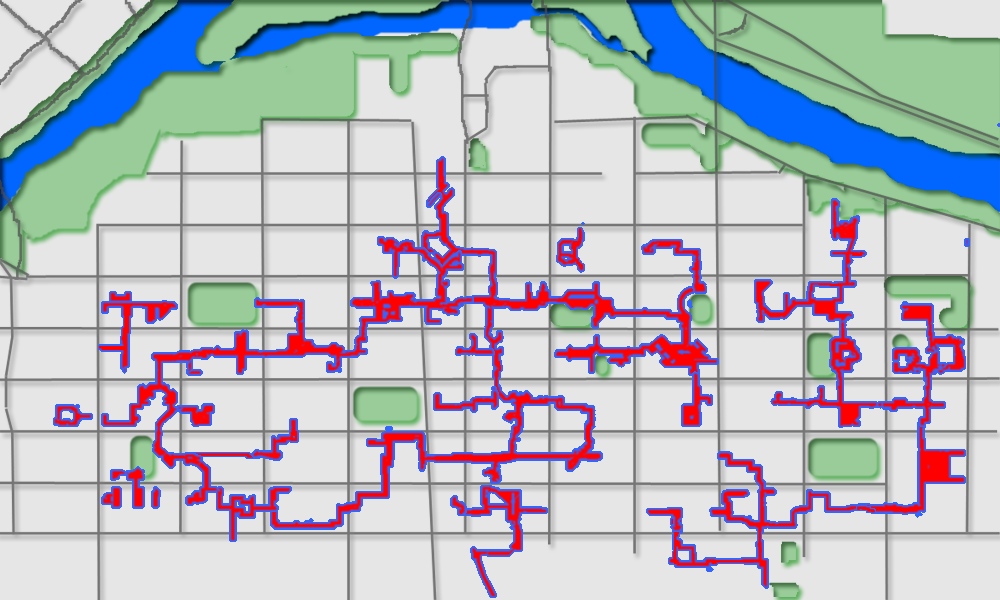
A Plus 15 bridge with abstract metal sculptures in Calgary's downtown core. Image by Spatial Mongrel.
Calgary, Alberta, Canada is a city of around 1 million people. It’s the financial centre of Canada’s petrol economy and is very, very cold. Average temperatures range from a low of -15°C (5°F) to a high of 10°C (49°F).
Calgarians are therefore blessed with a network of elevated walkways called the Plus 15 System. This network enables movement throughout the financial district and downtown core without stepping outside. The Plus 15 network’s 16 km of length and 59 bridges make it the largest such system in the world.
The Plus 15, whose name refers to the height at which these bridges are above street level, is not without controversy. Some feel that the network’s 16 km and 59 bridges rob the street of pedestrian traffic and life. But that’s not the point or reason I wish to draw attention to this system.
Instead, consider the following images:

A multistory bridge is just one of 59 bridges that make up Calgary's Plus 15 Network. Image by the Calgary Downtown Association.
Some of the bridges are purely utilitarian and others are architectural marvels. But again, that’s not the point. In yesterday’s post we discussed the new Baden Gondelbahn proposal. One of the images from that new proposal was this:
See the point now? Integrating Urban Gondolas and Cable Propelled Transit into dense urban environments may not be so difficult after all.






3 Comments
I’m not quite clear what this form of transport enables that can’t be done far more cost effetively by ground based means. Rail based / wheel based systems are always more efficient where significant topographic challenges do not exist. You see cable systems at amusement parks. Why? For amusement. As a mass transit option they would be ineffectual. Really depends on ones goal/intention. Showpiece (fun) vs Practical (effective)
@ buddy,
“I’m not quite clear what this form of transport enables that can’t be done far more cost effetively by ground based means. Rail based / wheel based systems are always more efficient where significant topographic challenges do not exist.”
Generally speaking, gondola systems can be installed for 1/4 – 1/2 the cost of a comparable rail-based system – with or without topographical challenges.
You also have to take into consideration the incredibly short and reliable wait times between cabins – as short as 10 seconds between vehicles. You also have to factor into the equation the fact that vehicles will rarely (if ever) get into accidents with other vehicles.
They’re also quieter, (generally) more energy efficient and offer capacity levels equivalent to that which most North American LRT systems offer.
I think it interesting that you say “as a mass transit option they would be ineffectual” when there are more than a dozen of these systems operating around the world as fully-integrated components of mass transit systems. You can be cynical about the technology all you want, but there are enough real-world examples of this technology moving – literally – tens of thousands of people per day in mass transit applications. Your statement bears no witness to reality.
Just because something is a showpiece, doesn’t mean it can’t be effective and vice versa. You’re making a logical error: Just because something is at an amusement park, doesn’t mean it’s solely for amusement purposes. Sidewalks, stair cases, people movers, elevators, etc. are all features of amusement parks but that doesn’t mean they’re there solely for amusement purposes.
This isn’t to say cable/gondolas is some kind of cure-all. We’re not saying rip up your train tracks, fill in your subway tunnels and sell your busses. We’re merely saying this is one of many transit tools that planners should explore.
GREETINGS FROM COLOMBIA
I AM AN ARCHITECT AND METAL ARTIST AND ID LIKE TO KNOW THE NAME OF THE AUTOR OF THOSE WHITE SCULPTURES.
BESIDES I WANT YOUR AUTORIZATION TO PUBLISH THAT PIECE OF ART (WITH AUTORS CREDITS) IN MY BLOG TO VALIOUS INTERNATIONAL CONTEMPORARY URBAN METAL
WORKS.
THANKS IN ADVANCE AND COUNT ON ME PLEASE TO MAKE A SCULPTURE FOR YOUR URBAN PROJECTS. EVERY BODY WILL LOVE IT